Aloha, fellow adventurers! Are you dreaming of a Hawaiian escape that goes beyond the typical resort scene, immersing you in a world of lush rainforests, cascading waterfalls, and vibrant local culture? Then set your sights on Hilo, the captivating heart of the Big Island’s east coast. Often overshadowed by its drier Kona counterpart, Hilo offers a distinctly different, deeply authentic Hawaiian experience, where nature reigns supreme and history whispers from every corner. Imagine waking to the gentle pitter-patter of rain, knowing it nourishes the emerald landscapes you’re about to explore, from active volcanoes to serene botanical gardens.
Hilo is a place where rainbows are a daily occurrence, where the ocean meets ancient lava flows, and where the spirit of aloha is palpable. To truly savor Hilo, consider visiting during the shoulder seasons of April-May or September-October for pleasant weather and fewer crowds, though its tropical climate ensures beauty year-round. Get ready to discover a side of Hawaii that will capture your heart and ignite your wanderlust.
‘Akaka Falls State Park
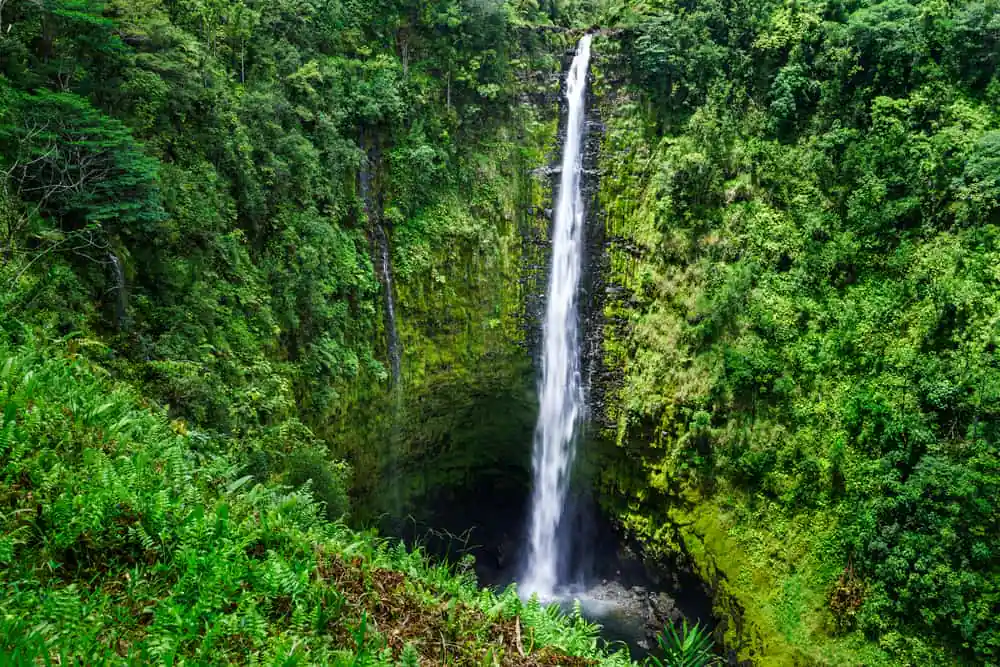
Prepare to be mesmerized as you step into the verdant embrace of ‘Akaka Falls State Park, home to one of Hawaii’s most iconic and accessible waterfalls. This isn’t just a quick photo stop; it’s a journey through a lush, tropical rainforest where the air hums with life. A paved, loop trail, approximately 0.4 miles, guides you through a canopy of bamboo groves, wild orchids, and towering ferns, culminating in two breathtaking viewpoints.
First, you’ll glimpse Kahuna Falls, a smaller but still impressive cascade, before the grand reveal of ‘Akaka Falls itself. Plunging a staggering 442 feet into a stream-eroded gorge, its sheer power and beauty are humbling. The path is well-maintained, making it a comfortable walk for most, and the vibrant greenery surrounding you feels like a scene from a prehistoric paradise. This park offers a perfect blend of natural wonder and easy exploration, making it a must-visit for anyone seeking Hawaii’s iconic waterfall magic.
📍 Visitor Information
Liliʻuokalani Park and Gardens
Just a stone’s throw from downtown Hilo, you’ll discover the serene beauty of Liliʻuokalani Park and Gardens, an authentic Japanese garden gifted to the city in the early 20th century. Named in honor of Hawaii’s last reigning monarch, Queen Liliʻuokalani, this 30-acre oasis is a testament to cultural exchange and natural harmony.
As you wander along the winding pathways, you’ll encounter traditional Japanese bridges, tranquil pagodas, stone lanterns, and a picturesque teahouse, all set amidst meticulously manicured gardens, ponds teeming with koi, and swaying banyan trees. The garden offers stunning panoramic views of Hilo Bay and the iconic Coconut Island, making it a popular spot for leisurely strolls, picnics, and photography. It’s a place designed for contemplation and quiet enjoyment, providing a peaceful escape from the hustle and bustle, inviting you to slow down and appreciate its intricate details and calming atmosphere.
📍 Visitor Information
Hilo Farmers’ Market
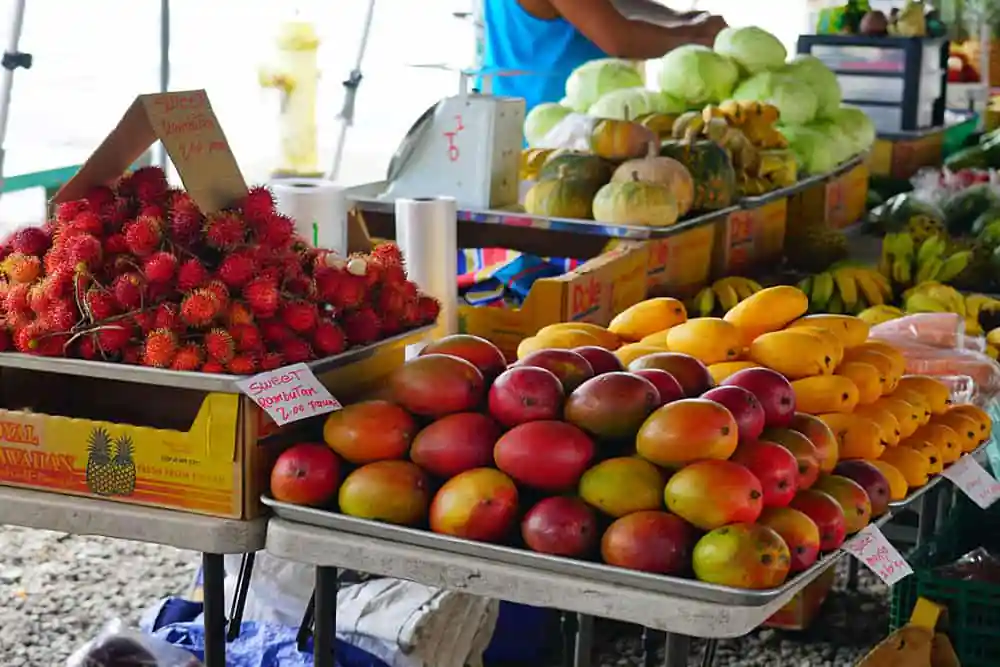
For an authentic taste of local life and a vibrant sensory experience, the Hilo Farmers’ Market is an absolute must-visit. Twice a week, this bustling market transforms the corner of Kamehameha Avenue and Mamo Street into a kaleidoscope of colors, sounds, and aromas. You’ll find an incredible array of fresh, locally grown produce, from exotic tropical fruits like rambutan and lychee to vibrant vegetables you might not recognize.
Beyond the edible delights, the market is a treasure trove of artisanal crafts, handmade jewelry, local artwork, and unique souvenirs, all created by talented islanders. The air is filled with the chatter of vendors, the melodies of live music, and the enticing scent of freshly prepared local foods. It’s not just a place to shop; it’s a community gathering, a cultural hub where you can connect with local farmers and artisans, learning about their passions and products.
📍 Visitor Information
Richardson Ocean Park
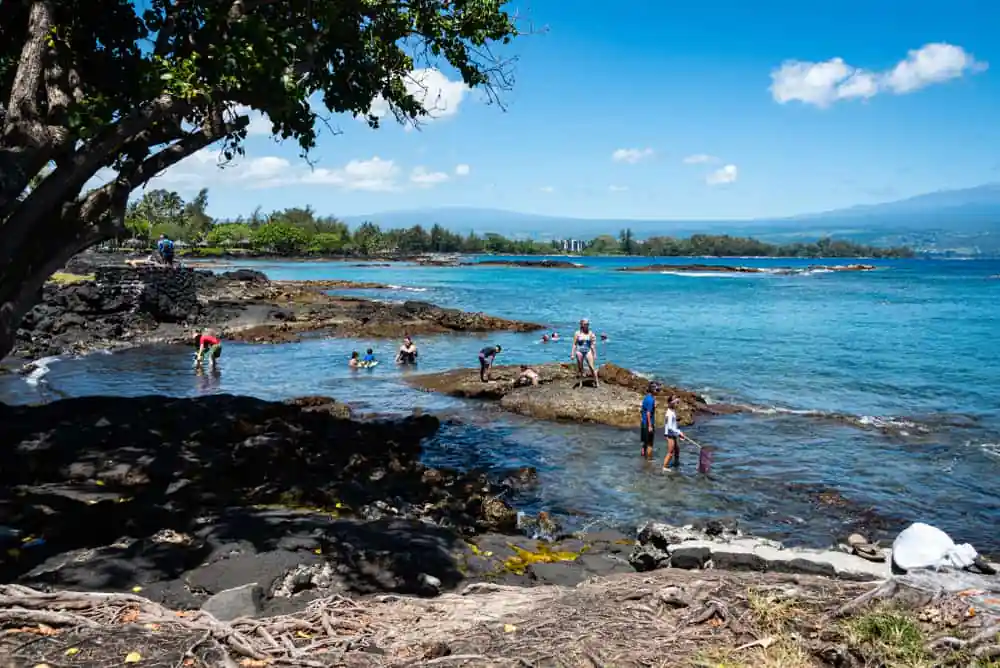
Nestled along the scenic coastline, Richardson Ocean Park offers a unique black sand beach experience combined with calm, protected waters perfect for families and snorkelers. Unlike many Big Island beaches formed by fine volcanic sand, Richardson’s dark “sand” is actually made of tiny lava fragments, creating a striking contrast with the turquoise ocean.
What makes this park truly special are its natural freshwater springs that bubble up into the ocean, creating cool pockets in the water – a refreshing surprise! The protective reef makes the bay incredibly calm, ideal for swimming, snorkeling, and even paddleboarding. You’ll often spot green sea turtles (honu) gracefully gliding through the clear waters or basking on the rocks, adding to the magic. It’s a beloved local spot, offering a serene escape and a safe environment to enjoy Hilo’s unique coastal beauty.
📍 Visitor Information
ʻImiloa Astronomy Center
Embark on a captivating journey through the cosmos and Hawaiian culture at the ʻImiloa Astronomy Center. Perched on a hill overlooking Hilo, this innovative center bridges the gap between ancient Polynesian voyaging traditions and modern astronomical discoveries, particularly those made from the summit of Maunakea. You’ll be drawn into immersive exhibits that explain the formation of the universe, the life cycle of stars, and the incredible science behind Hawaii’s world-class observatories.
The highlight is undoubtedly the planetarium, where you can watch stunning full-dome shows that transport you through space or explore the celestial navigation techniques of early Hawaiians. Beyond the stars, ʻImiloa celebrates the deep connection between Hawaiian culture and the sky, showcasing how ancient Hawaiians used the stars for navigation, planting, and fishing. It’s an educational and inspiring experience for all ages, offering a unique perspective on Hawaii’s place in the universe.
📍 Visitor Information
Rainbow Falls

Just minutes from downtown Hilo, Rainbow Falls is one of the island’s most iconic and easily accessible natural wonders, famous for the ethereal rainbows that often appear in its mist. Fed by the Wailuku River, this powerful waterfall plunges 80 feet over a natural lava cave, creating a mesmerizing spectacle. The best time to witness the eponymous rainbow is in the morning, typically between 9 AM and 10 AM, when the sun’s rays hit the mist at just the right angle, painting vibrant arcs across the gorge.
The park surrounding the falls is small but beautifully maintained, with towering banyan trees and lush tropical foliage. A short, paved path leads to the main viewing platform, offering fantastic photo opportunities. For a different perspective, you can climb the stairs to the top of the falls, where you’ll find a serene pool and ancient banyan tree roots that create an otherworldly atmosphere.
📍 Visitor Information
Carlsmith Beach Park
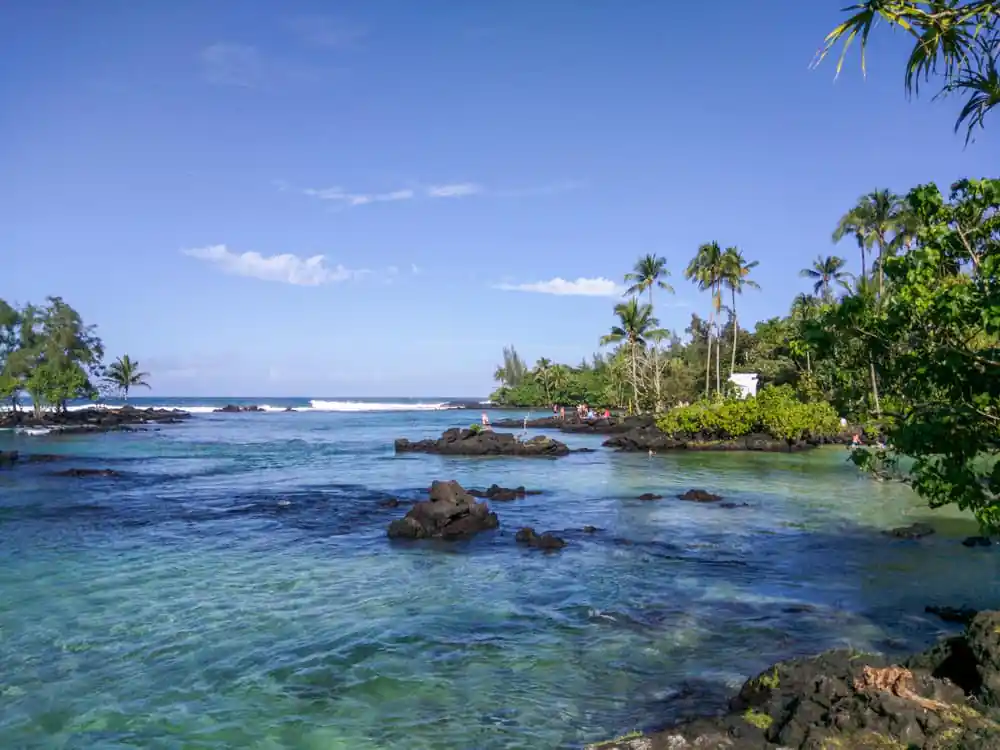
Carlsmith Beach Park, locally known as Four Mile, is a true gem offering a unique and incredibly safe swimming experience. Unlike typical sandy beaches, Carlsmith features a series of tranquil, spring-fed lagoons protected by a natural lava rock barrier. This creates incredibly calm, crystal-clear pools that are perfect for swimming, snorkeling, and even paddleboarding, regardless of ocean conditions.
The water here is a fascinating mix of cool freshwater springs and warmer ocean water, creating distinct temperature zones. You’ll often find green sea turtles gracefully swimming alongside you or basking on the grassy banks, making for unforgettable encounters. The park boasts expansive grassy areas shaded by ironwood trees, ideal for picnics and relaxation. It’s a favorite among locals and families, providing a serene and safe environment to enjoy Hilo’s beautiful coastline without the worry of strong currents or waves.
📍 Visitor Information
Coconut Island
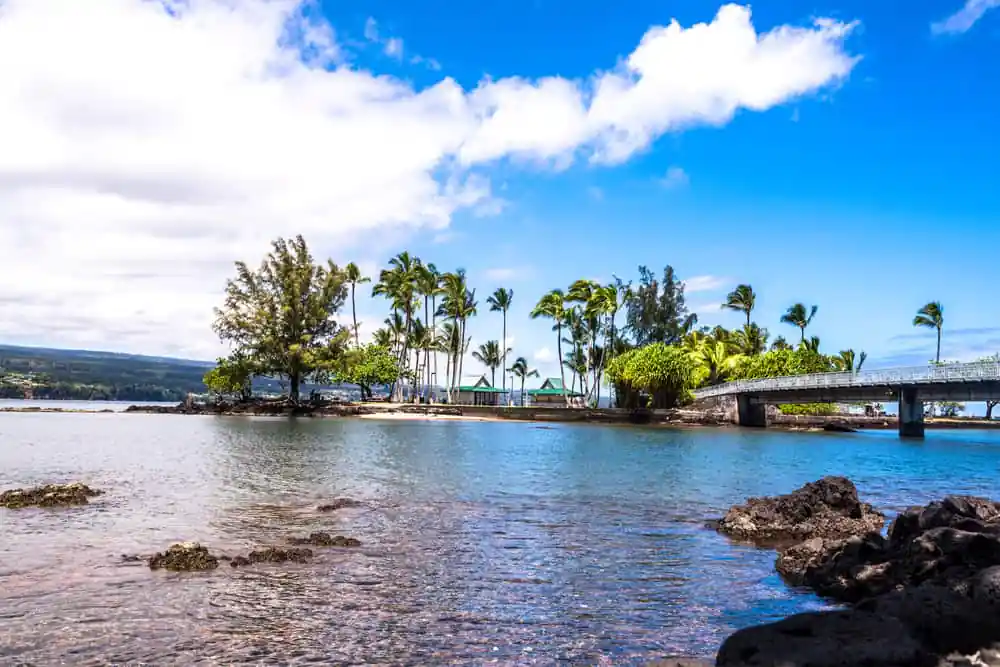
Just offshore from Liliʻuokalani Park and Gardens, connected by a quaint footbridge, lies Coconut Island, or Mokuola as it’s known in Hawaiian. This small, picturesque island is a beloved local park and a fantastic spot for families and anyone seeking a relaxing afternoon. Mokuola translates to “island of life” or “healing island,” and it certainly lives up to its name, offering a tranquil escape with stunning views of Hilo Bay and Maunakea in the distance.
The island features grassy lawns perfect for picnics, a small sandy beach area, and several tide pools to explore. A popular activity for the adventurous is jumping off the concrete tower into the clear, refreshing bay waters. It’s a wonderful place to watch the sunset, enjoy a leisurely stroll, or simply soak in the peaceful ambiance while watching local fishermen and paddleboarders.
📍 Visitor Information
Mokupāpapa Discovery Center
Dive deep into the wonders of the Pacific at the Mokupāpapa Discovery Center, a fascinating and free museum dedicated to the Papahānaumokuākea Marine National Monument. This immense protected area, one of the largest marine conservation areas in the world, stretches northwest from the main Hawaiian Islands and is a UNESCO World Heritage site.
The center brings this remote and largely unexplored ocean world to life through engaging, interactive exhibits. You’ll marvel at a 3,500-gallon saltwater aquarium showcasing vibrant coral reef ecosystems, explore models of deep-sea exploration vehicles, and learn about the unique marine life, including monk seals and green sea turtles, that call this monument home. It’s an educational journey that highlights the importance of ocean conservation and the incredible biodiversity of Hawaii’s waters, offering a glimpse into a part of the world few will ever see firsthand.
📍 Visitor Information
Panaewa Rainforest Zoo
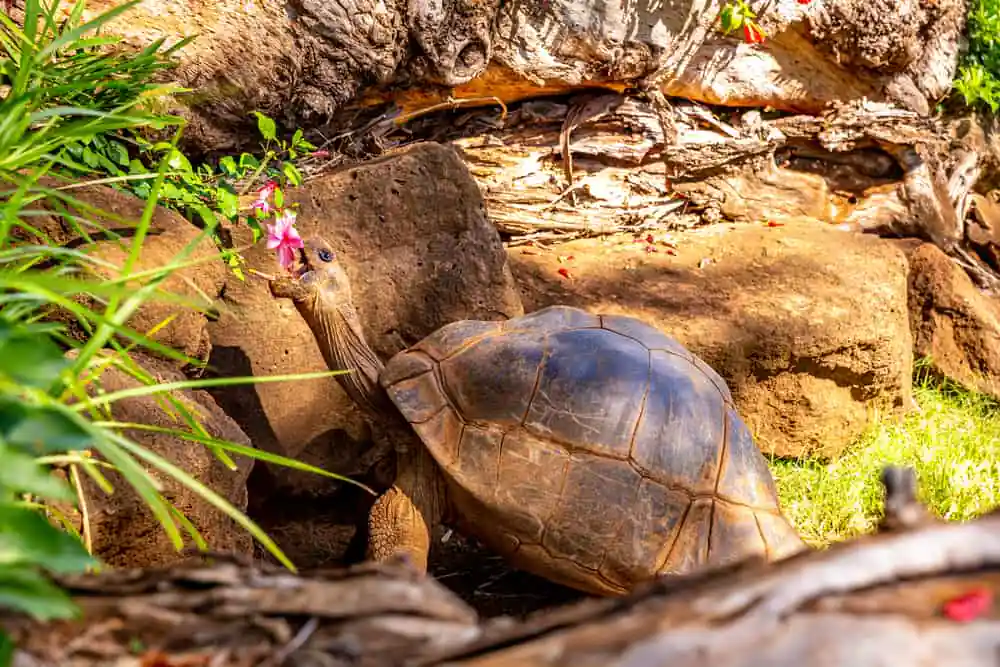
Escape into a lush, tropical wonderland at the Panaewa Rainforest Zoo and Gardens, the only tropical rainforest zoo in the United States and, remarkably, free to enter! Nestled within a genuine rainforest, this unique zoo offers an intimate encounter with a diverse collection of animals from around the world, as well as native Hawaiian species. You’ll wander along shaded paths, surrounded by vibrant flora, encountering playful spider monkeys, majestic tigers, colorful macaws, and the rare nene (Hawaiian goose).
The zoo is also home to an impressive botanical garden, featuring over 100 varieties of palms, orchids, and other exotic plants, making it a beautiful botanical experience in its own right. It’s a wonderful outing for families, animal lovers, and anyone looking to enjoy nature in a relaxed, accessible setting, offering a chance to connect with wildlife in an authentic rainforest environment.
📍 Visitor Information
Pacific Tsunami Museum
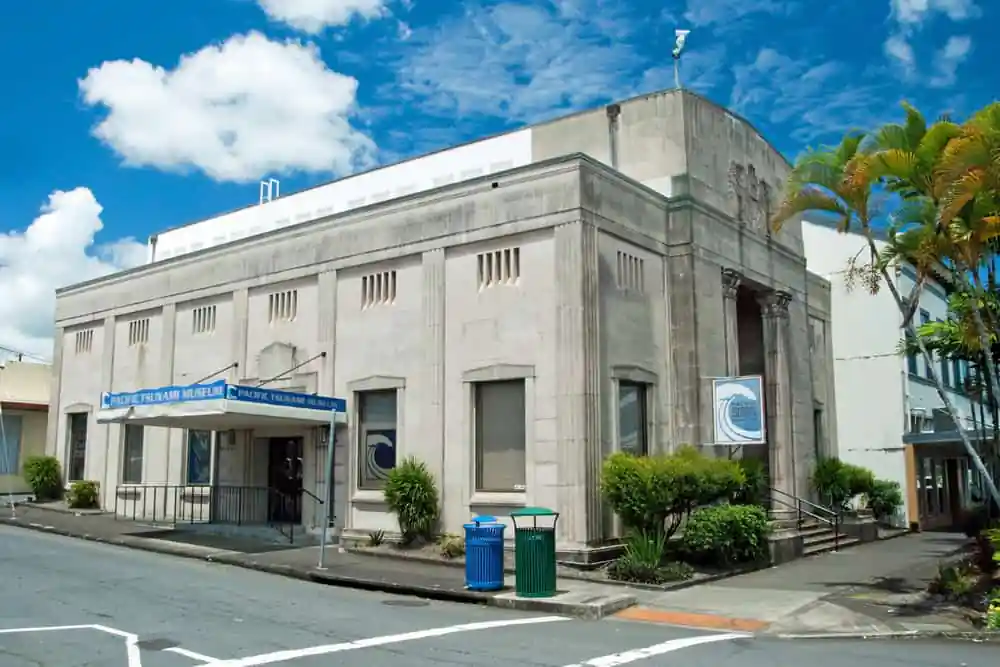
Delve into a powerful and sobering chapter of Hilo’s history at the Pacific Tsunami Museum. Located in a historic building downtown, this museum serves as a poignant memorial to the devastating tsunamis that have impacted Hilo, particularly those in 1946 and 1960, which reshaped the town and claimed many lives.
Through compelling exhibits, survivor testimonies, and historical photographs, you’ll gain a profound understanding of these natural disasters, the science behind tsunamis, and the importance of preparedness. The museum does an excellent job of honoring the victims while also educating visitors on the resilience of the community and the advancements in warning systems. It’s an emotional yet incredibly important visit, offering deep insight into the unique challenges and triumphs of living on this dynamic island, reminding you of the ocean’s immense power and the strength of the human spirit.
📍 Visitor Information
Kaumana Caves State Park
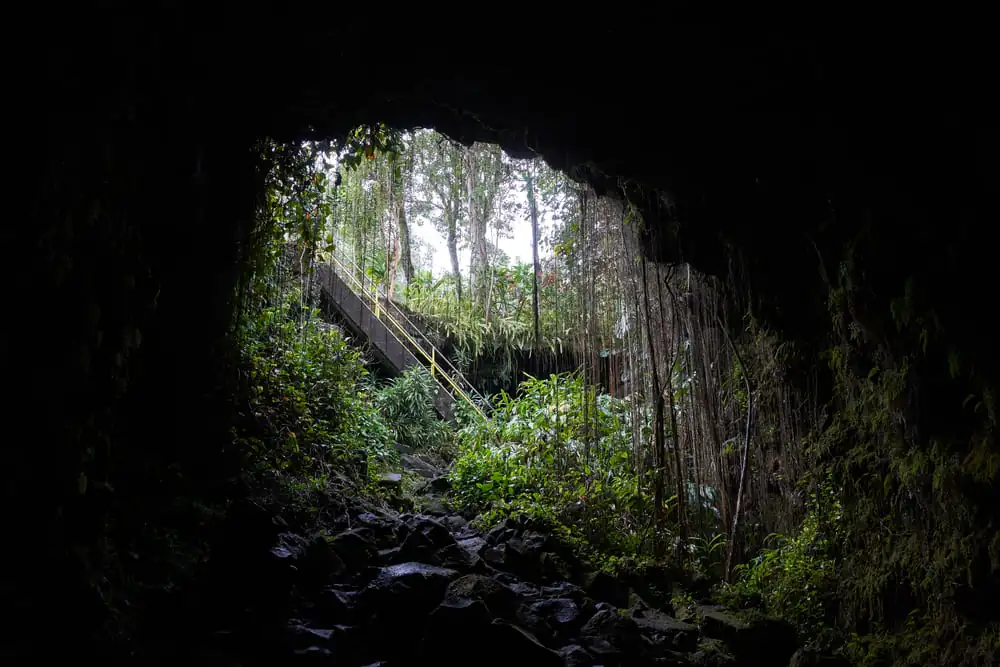
Embark on a subterranean adventure at Kaumana Caves State Park, where you can explore a portion of a massive lava tube formed by the 1881 eruption of Mauna Loa. Unlike some commercialized cave systems, Kaumana Caves offers a raw, natural experience, allowing you to venture into the cool, dark interior with just a flashlight and a sense of adventure. You’ll descend a set of stairs into the gaping mouth of the cave, then choose to explore either the tube heading left or right.
The ground is uneven and rocky, so sturdy shoes are a must, but the experience of walking through ancient lava flows is truly unique. You’ll see fascinating lava formations, feel the cool, damp air, and gain an appreciation for the island’s volcanic origins. It’s a thrilling, off-the-beaten-path experience that connects you directly with the powerful geological forces that shaped Hawaii.
📍 Visitor Information
Lyman Museum
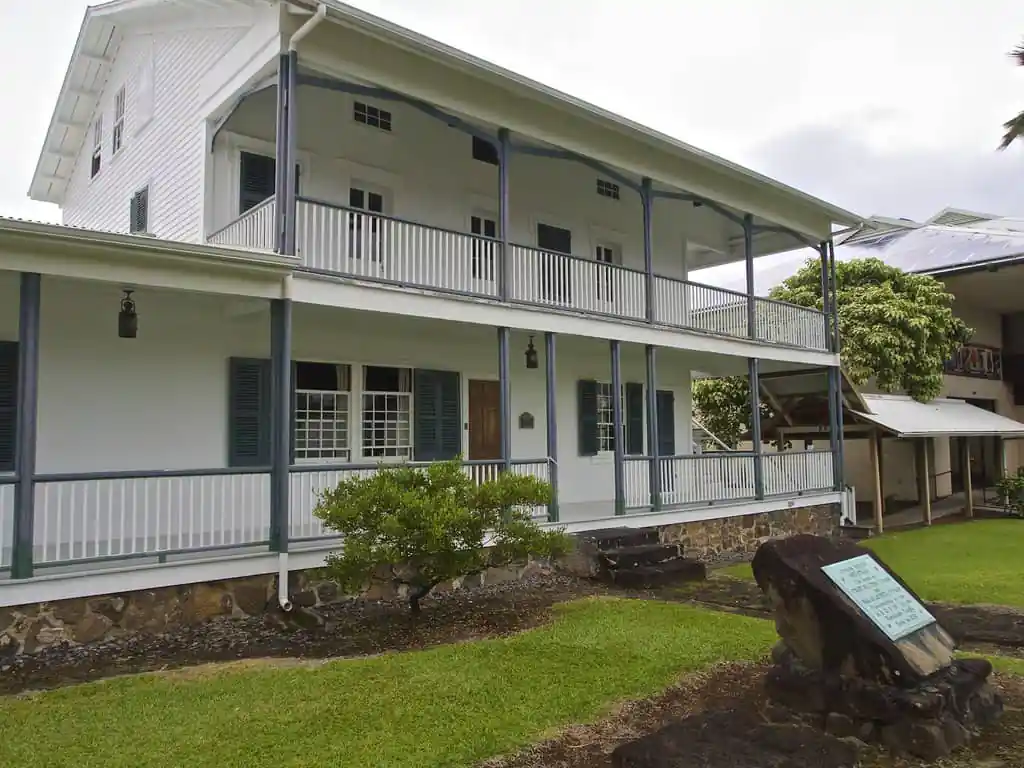
Step back in time and uncover the rich natural and cultural history of Hawaii at the Lyman Museum. Housed in two distinct buildings – a beautiful 1856 missionary home and a modern museum wing – this institution offers a comprehensive look at the islands’ past. In the missionary home, you’ll explore the lives of early American missionaries, seeing original furnishings and artifacts that tell the story of their arrival and impact.
The main museum wing, however, is where Hawaii’s natural wonders and diverse cultures truly shine. You’ll discover fascinating exhibits on volcanic geology, the unique flora and fauna of the islands, and the vibrant heritage of Hawaii’s various ethnic groups. From ancient Hawaiian tools to intricate geological specimens, the Lyman Museum provides a deep, educational dive into what makes this island chain so extraordinary, offering context and understanding to everything else you see on your trip.
📍 Visitor Information
Hawai’i Volcanoes National Park
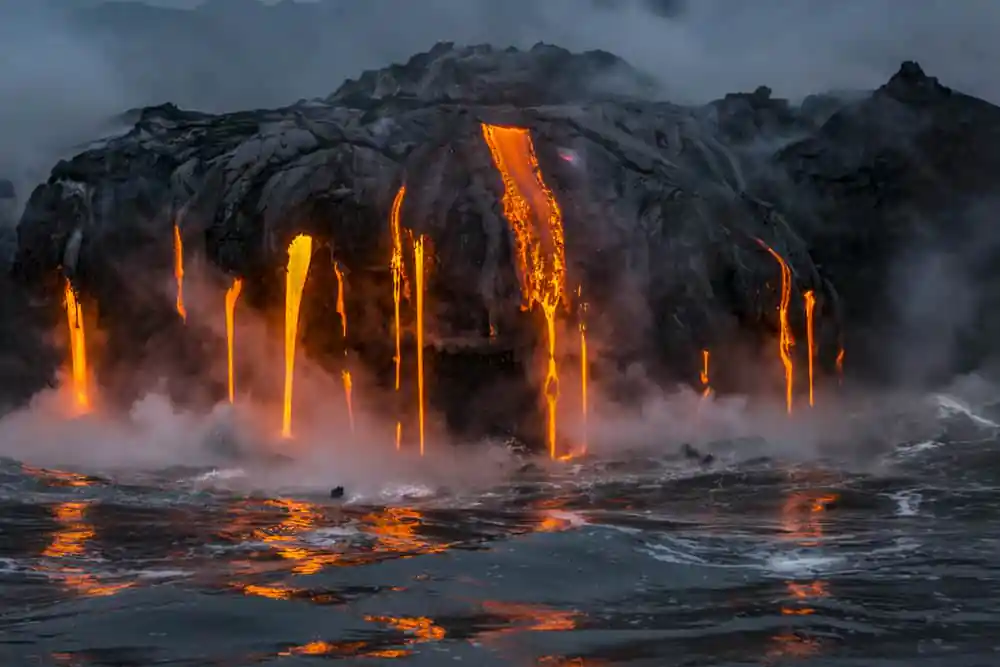
No visit to Hilo is complete without venturing into the awe-inspiring realm of Hawai’i Volcanoes National Park, a UNESCO World Heritage site and home to two of the world’s most active volcanoes, Kīlauea and Mauna Loa. This living landscape is constantly being shaped by volcanic activity, offering a truly unique and dynamic experience. You’ll drive along scenic Crater Rim Drive, stopping at various viewpoints to witness steam vents billowing from the earth, vast caldera floors, and ancient lava flows that stretch for miles.
Explore the Thurston Lava Tube, a massive underground tunnel formed by flowing lava, or embark on a hike across solidified lava fields. The park offers an unparalleled opportunity to witness the raw power of creation and destruction, providing a profound connection to the Earth’s geological processes. Whether you visit during the day to explore its diverse ecosystems or at night hoping to catch a glimpse of a fiery glow, it’s an unforgettable adventure.
📍 Visitor Information
Hamakua Coast Scenic Drive
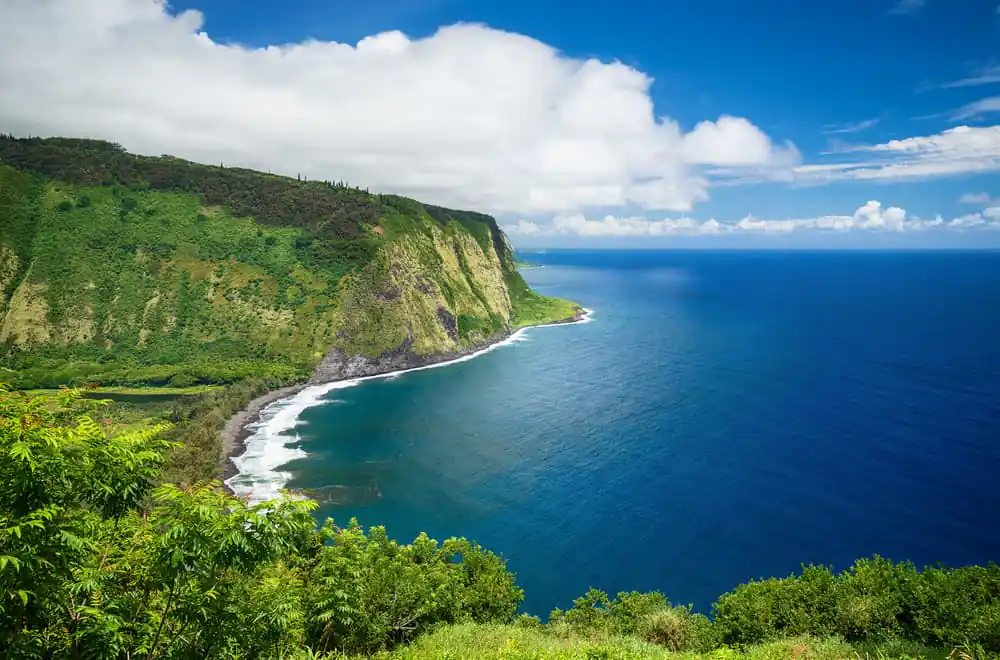
Prepare for a journey of unparalleled beauty along the Hamakua Coast Scenic Drive, a breathtaking stretch of Highway 19 just north of Hilo. This drive is a feast for the senses, winding through lush, emerald valleys, past dramatic sea cliffs, and over historic bridges that span cascading waterfalls. You’ll be immersed in a landscape carved by centuries of rain and volcanic activity, resulting in deep gulches and vibrant green slopes that plunge into the Pacific Ocean.
Stop at viewpoints like the Waipio Valley Lookout for panoramic vistas of the “Valley of Kings,” or pull over at the various small parks and lookouts to admire hidden waterfalls like Kolekole Falls. The drive itself is the attraction, offering continuous stunning scenery, charming small towns, and a true sense of old Hawaii. It’s the perfect way to spend a leisurely day, soaking in the island’s natural grandeur and escaping into a world of verdant beauty.
📍 Visitor Information
Plan Your Visit
As you can see, Hilo is far more than just a gateway to the Big Island’s volcanoes; it’s a destination brimming with its own unique charm, waiting to be explored. From the powerful cascades of ‘Akaka Falls to the serene tranquility of Japanese gardens, and from the vibrant buzz of the farmers’ market to the profound depths of a lava tube, Hilo offers an incredible tapestry of experiences. You’ll discover a Hawaii that is raw, authentic, and deeply connected to its natural and cultural roots.
Whether you’re a nature enthusiast, a history buff, a family seeking safe adventures, or a solo traveler craving genuine immersion, Hilo promises unforgettable moments. So pack your rain jacket, your sense of wonder, and your aloha spirit, and prepare to be captivated by the Big Island’s lush, vibrant heart. Start planning your Hilo adventure today – the magic of the east side awaits!

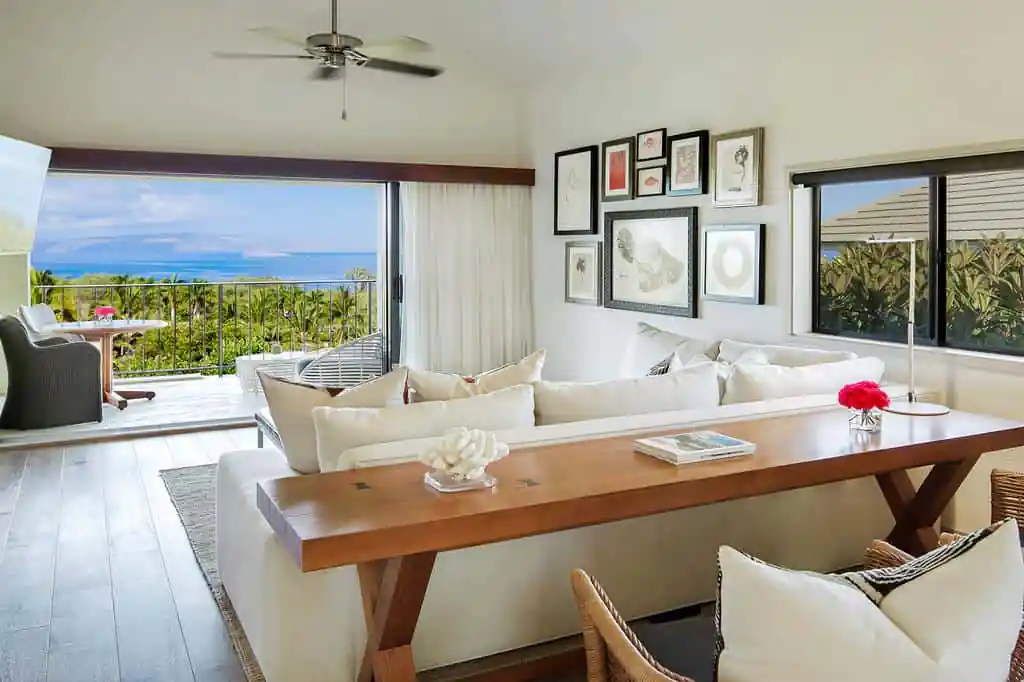
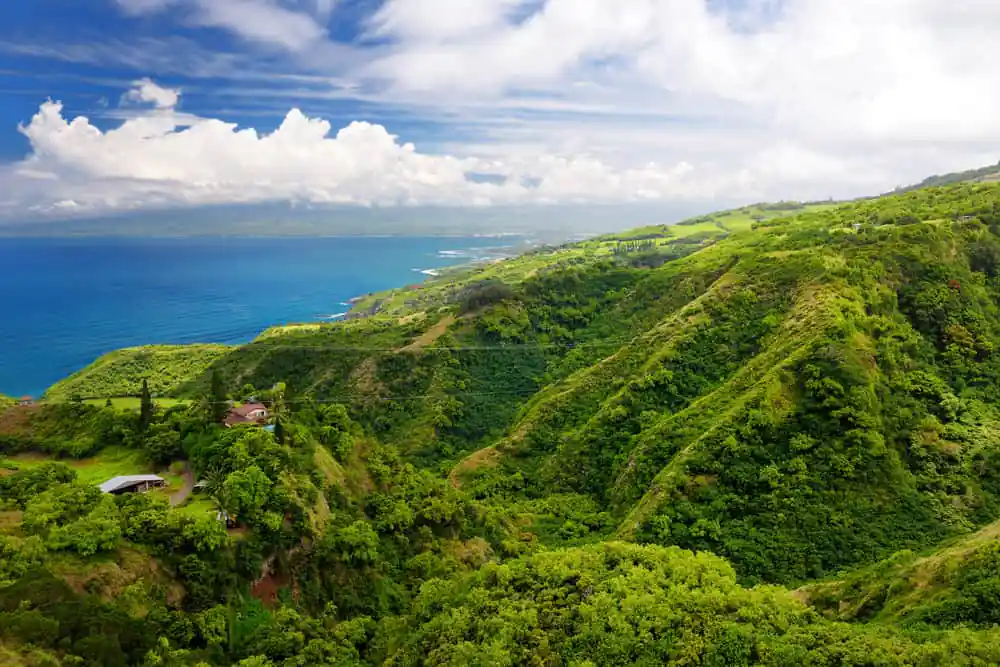
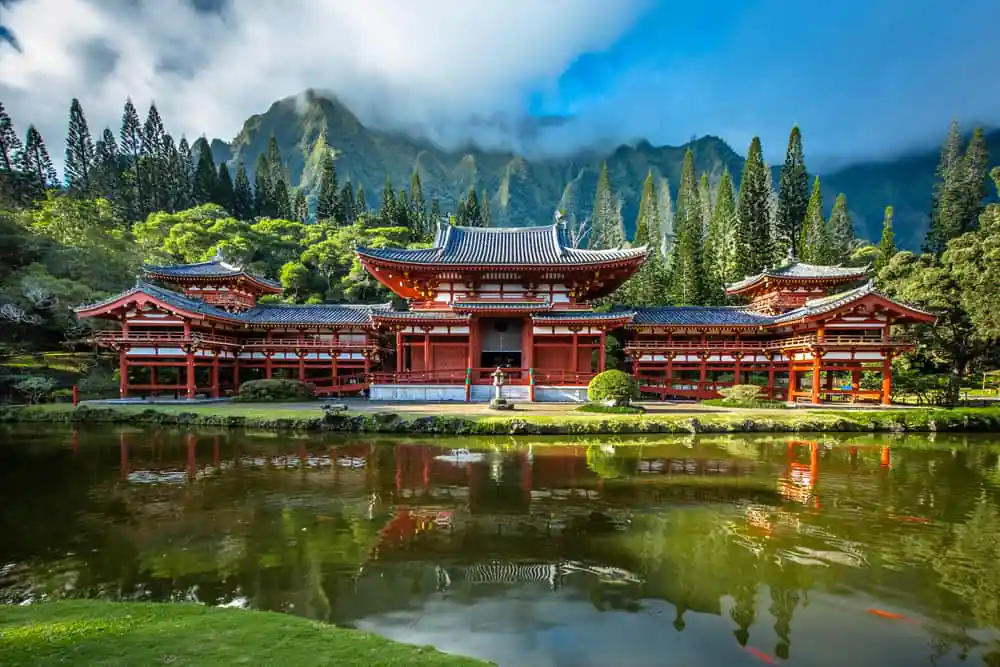
Join the Conversation